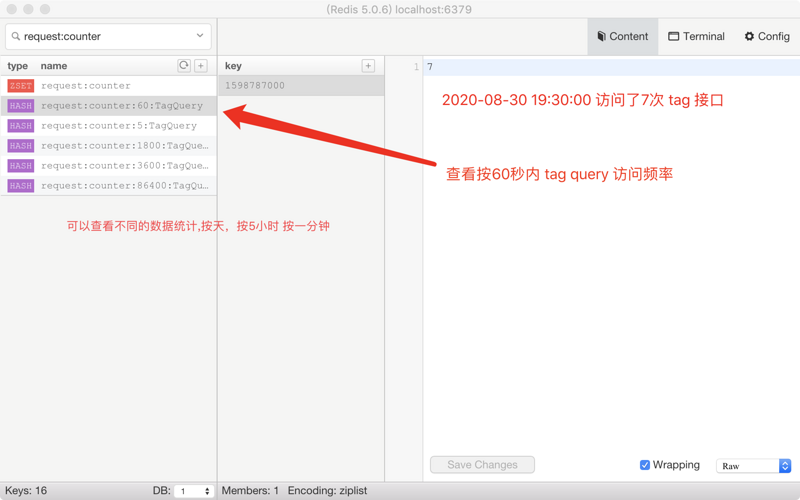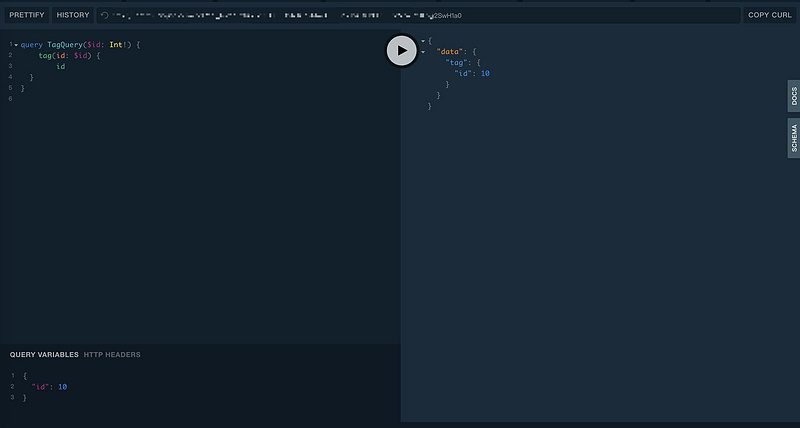您好,登錄后才能下訂單哦!
您好,登錄后才能下訂單哦!
這篇文章主要介紹“Laravel中GraphQL接口請求頻率案例講解”,在日常操作中,相信很多人在Laravel中GraphQL接口請求頻率案例講解問題上存在疑惑,小編查閱了各式資料,整理出簡單好用的操作方法,希望對大家解答”Laravel中GraphQL接口請求頻率案例講解”的疑惑有所幫助!接下來,請跟著小編一起來學習吧!
前言
起源:通常在產品的運行過程,我們可能會做數據埋點,以此來知道用戶觸發的行為,訪問了多少頁面,做了哪些操作,來方便產品根據用戶喜好的做不同的調整和推薦,同樣在服務端開發層面,也要做好“數據埋點”,去記錄接口的響應時長、接口調用頻率,參數頻率等,方便我們從后端角度去分析和優化問題,如果遇到異常行為或者大量攻擊來源,我們可以具體針對到某個接口去進行優化。
項目環境:
framework:laravel 5.8+
cache : redis >= 2.6.0
目前項目中幾乎都使用的是 graphql 接口,采用的 package 是 php lighthouse graphql,那么主要的場景就是去統計好,graphql 接口的請求次數即可。
實現GraphQL Record Middleware
首先建立一個middleware 用于稍后記錄接口的請求頻率,在這里可以使用artisan 腳手架快速創建:
php artisan make:middleware GraphQLRecord
<?php
namespace App\Http\Middleware;
use Closure;
class GraphQLRecord
{
/**
* Handle an incoming request.
*
* @param \Illuminate\Http\Request $request
* @param \Closure $next
* @return mixed
*/
public function handle($request, Closure $next)
{
return $next($request);
}
}然后添加到 app/config/lighthouse.php middleware 配置中,或后添加到項目中 app/Http/Kernel.php 中,設置為全局中間件
'middleware' => [ \App\Http\Middleware\GraphQLRecord::class, \Nuwave\Lighthouse\Support\Http\Middleware\AcceptJson::class, ],
獲取 GraphQL Operation Name
public function handle($request, Closure $next)
{
$opName = $request->get('operationName');
return $next($request);
}獲取到 Operation Name 之后,開始就通過在Redis 來實現一個接口計數器。
添加接口計數器
首先要設置我們需要記錄的時間,如5秒,60秒,半小時、一個小時、5個小時、24小時等,用一個數組來實現,具體可以根據自我需求來調整。
const PRECISION = [5, 60, 1800, 3600, 86400];
然后就開始添加對接口計數的邏輯,計數完成后,我們將其添加到zsset中,方便后續進行數據查詢等操作。
/**
* 更新請求計數器
*
* @param string $opName
* @param integer $count
* @return void
*/
public function updateRequestCounter(string $opName, $count = 1)
{
$now = microtime(true);
$redis = self::getRedisConn();
if ($redis) {
$pipe = $redis->pipeline();
foreach (self::PRECISION as $prec) {
//計算時間片
$pnow = intval($now / $prec) * $prec;
//生成一個hash key標識
$hash = "request:counter:{$prec}:$opName";
//增長接口請求數
$pipe->hincrby($hash, $pnow, 1);
// 添加到集合中,方便后續數據查詢
$pipe->zadd('request:counter', [$hash => 0]);
}
$pipe->execute();
}
}
/**
* 獲取Redis連接
*
* @return object
*/
public static function getRedisConn()
{
$redis = Redis::connection('cache');
try {
$redis->ping();
} catch (Exception $ex) {
$redis = null;
//丟給sentry報告
app('sentry')->captureException($ex);
}
return $redis;
}然后請求一下接口,用medis查看一下數據。


查詢、分析數據
數據記錄完善后,可以通過opName 及 prec兩個屬性來查詢,如查詢24小時的tag接口訪問數據
/**
* 獲取接口訪問計數
*
* @param string $opName
* @param integer $prec
* @return array
*/
public static function getRequestCounter(string $opName, int $prec)
{
$data = [];
$redis = self::getRedisConn();
if ($redis) {
$hash = "request:counter:{$prec}:$opName";
$hashData = $redis->hgetall($hash);
foreach ($hashData as $k => $v) {
$date = date("Y/m/d", $k);
$data[] = ['timestamp' => $k, 'value' => $v, 'date' => $date];
}
}
return $data;
}獲取 tag 接口 24小時的訪問統計
$data = $this->getRequestCounter('tagQuery', '86400');清除數據
完善一系列步驟后,我們可能需要將過期和一些不必要的數據進行清理,可以通過定時任務來進行定期清理,相關實現如下:
/**
* 清理請求計數
*
* @param integer $clearDay
* @return void
*/
public function clearRequestCounter($clearDay = 7)
{
$index = 0;
$startTime = microtime(true);
$redis = self::getRedisConn();
if ($redis) {
//可以清理的情況下
while ($index < $redis->zcard('request:counter')) {
$hash = $redis->zrange('request:counter', $index, $index);
$index++;
//當前hash存在
if ($hash) {
$hash = $hash[0];
//計算刪除截止時間
$cutoff = intval(microtime(true) - ($clearDay * 24 * 60 * 60));
//優先刪除時間較遠的數據
$samples = array_map('intval', $redis->hkeys($hash));
sort($samples);
//需要刪除的數據
$removes = array_filter($samples, function ($item) use (&$cutoff) {
return $item <= $cutoff;
});
if (count($removes)) {
$redis->hdel($hash, ...$removes);
//如果整個數據都過期了的話,就清除掉統計的數據
if (count($removes) == count($samples)) {
$trans = $redis->transaction(['cas' => true]);
try {
$trans->watch($hash);
if (!$trans->hlen($hash)) {
$trans->multi();
$trans->zrem('request:counter', $hash);
$trans->execute();
$index--;
} else {
$trans->unwatch();
}
} catch (\Exception $ex) {
dump($ex);
}
}
}
}
}
dump('清理完成');
}
}清理一個30天前的數據:
$this->clearRequestCounter(30);
整合代碼
我們將所有操作接口統計的代碼,單獨封裝到一個類中,然后對外提供靜態函數調用,既實現了職責單一,又方便集成到其他不同的模塊使用。
<?php
namespace App\Helpers;
use Illuminate\Support\Facades\Redis;
class RequestCounter
{
const PRECISION = [5, 60, 1800, 3600, 86400];
const REQUEST_COUNTER_CACHE_KEY = 'request:counter';
/**
* 更新請求計數器
*
* @param string $opName
* @param integer $count
* @return void
*/
public static function updateRequestCounter(string $opName, $count = 1)
{
$now = microtime(true);
$redis = self::getRedisConn();
if ($redis) {
$pipe = $redis->pipeline();
foreach (self::PRECISION as $prec) {
//計算時間片
$pnow = intval($now / $prec) * $prec;
//生成一個hash key標識
$hash = self::counterCacheKey($opName, $prec);
//增長接口請求數
$pipe->hincrby($hash, $pnow, 1);
// 添加到集合中,方便后續數據查詢
$pipe->zadd(self::REQUEST_COUNTER_CACHE_KEY, [$hash => 0]);
}
$pipe->execute();
}
}
/**
* 獲取Redis連接
*
* @return object
*/
public static function getRedisConn()
{
$redis = Redis::connection('cache');
try {
$redis->ping();
} catch (Exception $ex) {
$redis = null;
//丟給sentry報告
app('sentry')->captureException($ex);
}
return $redis;
}
/**
* 獲取接口訪問計數
*
* @param string $opName
* @param integer $prec
* @return array
*/
public static function getRequestCounter(string $opName, int $prec)
{
$data = [];
$redis = self::getRedisConn();
if ($redis) {
$hash = self::counterCacheKey($opName, $prec);
$hashData = $redis->hgetall($hash);
foreach ($hashData as $k => $v) {
$date = date("Y/m/d", $k);
$data[] = ['timestamp' => $k, 'value' => $v, 'date' => $date];
}
}
return $data;
}
/**
* 清理請求計數
*
* @param integer $clearDay
* @return void
*/
public static function clearRequestCounter($clearDay = 7)
{
$index = 0;
$startTime = microtime(true);
$redis = self::getRedisConn();
if ($redis) {
//可以清理的情況下
while ($index < $redis->zcard(self::REQUEST_COUNTER_CACHE_KEY)) {
$hash = $redis->zrange(self::REQUEST_COUNTER_CACHE_KEY, $index, $index);
$index++;
//當前hash存在
if ($hash) {
$hash = $hash[0];
//計算刪除截止時間
$cutoff = intval(microtime(true) - ($clearDay * 24 * 60 * 60));
//優先刪除時間較遠的數據
$samples = array_map('intval', $redis->hkeys($hash));
sort($samples);
//需要刪除的數據
$removes = array_filter($samples, function ($item) use (&$cutoff) {
return $item <= $cutoff;
});
if (count($removes)) {
$redis->hdel($hash, ...$removes);
//如果整個數據都過期了的話,就清除掉統計的數據
if (count($removes) == count($samples)) {
$trans = $redis->transaction(['cas' => true]);
try {
$trans->watch($hash);
if (!$trans->hlen($hash)) {
$trans->multi();
$trans->zrem(self::REQUEST_COUNTER_CACHE_KEY, $hash);
$trans->execute();
$index--;
} else {
$trans->unwatch();
}
} catch (\Exception $ex) {
dump($ex);
}
}
}
}
}
dump('清理完成');
}
}
public static function counterCacheKey($opName, $prec)
{
$key = "request:counter:{$prec}:$opName";
return $key;
}
}在Middleware中使用.
<?php
namespace App\Http\Middleware;
use App\Helpers\RequestCounter;
use Closure;
class GraphQLRecord
{
/**
* Handle an incoming request.
*
* @param \Illuminate\Http\Request $request
* @param \Closure $next
* @return mixed
*/
public function handle($request, Closure $next)
{
$opName = $request->get('operationName');
if (!empty($opName)) {
RequestCounter::updateRequestCounter($opName);
}
return $next($request);
}
}結尾
上訴代碼就實現了基于GraphQL的請求頻率記錄,但是使用不止適用于GraphQL接口,也可以基于Rest接口、模塊計數等統計行為,只要有唯一的operation name即可。
到此,關于“Laravel中GraphQL接口請求頻率案例講解”的學習就結束了,希望能夠解決大家的疑惑。理論與實踐的搭配能更好的幫助大家學習,快去試試吧!若想繼續學習更多相關知識,請繼續關注億速云網站,小編會繼續努力為大家帶來更多實用的文章!
免責聲明:本站發布的內容(圖片、視頻和文字)以原創、轉載和分享為主,文章觀點不代表本網站立場,如果涉及侵權請聯系站長郵箱:is@yisu.com進行舉報,并提供相關證據,一經查實,將立刻刪除涉嫌侵權內容。